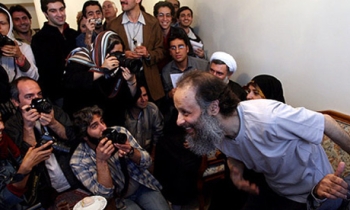CBS is having a terrific autumn. As a result, you're going to see more advertising.
The network's "CSI" has been the top-rated show among all networks and all viewers so far this season, with "CSI: Miami" and "Without a Trace" occupying two of the other top five slots. Overall, the network is No. 1 among viewers 18 to 49, the age group most sought after by advertisers. Last May, those advertisers paid at least $2.5 billion to buy up most of CBS's fall prime-time commercial slots, leading all networks.
But these days, that's hardly enough.
The network television business is not nearly as good relative to what it was five, 10 or certainly 20 years ago, when networks had a virtual lock on television ad dollars and commercials either featured a celebrity pitchman saying, "Buy this. It's good," or tried to sell you on a product that would make you feel smarter, taller, thinner or sexier. We viewers were held captive by the networks. We had no control. Also, we were dumber.
Today, however, we are smarter, have better toys and often turn anywhere but television networks for our video content. The networks have to figure out new ways to get our attention and have to understand the magnetic pull of the Internet to try and bend it to their advantage.
Which is why, last week, CBS parent Viacom Inc. announced a little-noticed step in trying to deliver advertising to you, taking a page from Google Inc.'s playbook by employing a tactic radically different from the 30- and 60-second commercials that have been television's bread-and-butter for decades.
Almost all of Viacom's CBS and UPN station Web sites are being revamped, the company said, to include a search technology from Kanoodle that displays sponsored advertising links along with news when viewers use the TV stations' Web sites.
For instance, if you visit the Web site for CBS's KYW station in Philadelphia and type "Donovan" into the site's search engine under the "news" heading, not only do you get stories and video about Philadelphia Eagles star quarterback Donovan McNabb, you get a sponsored link to Jim Donovan, a Philadelphia area motivational speaker. The technology is not foolproof: You also get a link to pop singer Donovan's Web site and a link to Donovan's Steak & Chop House, located in Phoenix and La Jolla, Calif. (Who knows? Maybe Donovan McNabb ate there once; he lives in Arizona.)
Compared with the rates CBS can charge for one 30-second commercial on "CSI," seen by 28 million viewers (about $400,000), the new sponsored-link Web searches are small potatoes. For now. All CBS has to do is look at Google's eye-popping quarterly earnings last month -- $381.2 million in profit, nearly six times that of the ad-dependent Washington Post Co., for instance -- to see where this could go.
"There really are a bunch of ideas that we're trying, seeing what pans out," said CBS spokesman Dana McClintock. "We're putting lots of stuff out there and trying to refine and optimize it."
If Google refines and optimizes its ideas any further, it may end up owning CBS. And every other network. Not to mention some sovereign nations and a moon or two.
Understanding the User
Network television advertising is like a fire hose -- everyone gets wet, including people who don't want to. Google fronts a growing pack of practitioners that think of advertising more like a Waterpik -- laser-sharp, forceful and directed at an individual spot.
Put aside network television's still-large but shrinking audience. Forget cable channels for the moment. Focus instead on the exploding number of ways that people consume -- and, more importantly, control -- their content: TiVo, video-on-demand, iPod music and video downloads, video on mobile phones, video on Sony PlayStations, music and video on the Internet, NetFlix, Movielink.com and so on.
Then add these recent announcements: CBS will sell on-demand episodes of its shows on Comcast cable for 99 cents, and NBC will do the same on DirecTV. Both will be new ad-delivery vehicles, in addition to new revenue streams for the networks. For an advertiser, each one of these technologies is a new pipeline into your ego and id. The key is finding the best way to worm in there.
But the advertising revolution is about more than just new tricks to get you to buy things. It's about changing your notion of advertising. Today's advertisers know that consumers have a good 60 years or so of practice in receiving and interpreting modern -- that is to say, television -- advertising. We have built up a certain degree of intelligence in decrypting advertising, not to mention cynicism about advertising's sincerity. To combat that, today's advertisers are trying to tell us: We're not trying to dupe you, we're trying to give you useful information about stuff and activities you like.
Five years ago the rage in Internet advertising was to guess what you were interested in and bombard you with ads only for hiking, say, or "Star Trek."
Today's successful Google ads are context-based, said Tim Armstrong, Google's vice president of advertising sales, attempting to "understand the intent of the user." In other words, Google learns you. One of the more controversial ways it learns you is by automatically scanning your e-mail if you have a Google Gmail account, looking for keywords that could link to products and serving up little related ads on the side of your messages. Google founders say Gmail keeps no record of the scans.
"Google started as an engine for understanding content," Armstrong said. "For years where we had Google but no ads, we were building up the understanding of content to get users to the right content.
"When we launched our advertising network," he said, "we used that understanding to put the right advertising in front of the right content and then in front of the right user."
Unlike conventional advertising -- if you buy space in a newspaper or on a television station, your ad will appear, regardless of how good it is -- Google's ads live in a ruthlessly efficient kill space. Sponsored links on Google appear more frequently in searches based on how many click-throughs they have received, Armstrong said. In other words, smarter and useful ads live long toward the front of the queue; dumb and useless ones -- even though they have been paid for -- shuffle themselves to the back of the line.
Google's dominance over the search-based advertising space has come quickly: The engine's ad offices have grown from one in the company's Mountain View, Calif., headquarters and one in Armstrong's New York apartment to more than 30 worldwide in the past five years.
The key, Armstrong said, is to understand the power shift that has occurred in advertising over recent decades.
"Users have had a tremendous increase in control, much more than 50 years ago or 20 years ago or 10 years ago," he said. "To be successful, the advertising industry needs to respect the user control."
Playing a New Game
Mitch Oscar has been in the ad game for 30 years.
An executive vice president for Carat Digital in New York, it's his job to buy the right time and space for his clients on any number of media platforms. For years, that has meant essentially one thing: He has a client, say, Ford Motor Co., and he uses Ford money to buy 30- and 60-second commercials on the four major television networks.
Now, that's all changed.
"Let's say I believe my client's product and CNN are a good match," he said. "So I say, 'If that's true and CNN has video-on-demand, I should be there. If they have broadband, I should be there. I'm anyplace CNN is.' " Not to mention, of course, actual live CNN on television.
Oscar is working with J.P. Morgan Chase & Co. on a credit card the company is rolling out. The card will have a chip with radio-frequency identification designed to speed consumer checkout. Chase thought the technology needed some explaining so consumers would understand the concept. More explaining than was possible in a minute or half-minute television commercial.
So it turned to a long-form, video-on-demand format. The card is rolling out in the Philadelphia market, so Comcast cable subscribers in that city will soon be able to see a long-form, information-packed ad for the credit card on Comcast's video-on-demand menu, alongside on-demand episodes of HBO and Showtime programs. "Infomercial" is the gross term, one that Oscar understandably hates.
The Comcast Spotlight program gives advertisers numerous new ways to reach viewers, usually by effectively camouflaging ads near, behind and alongside pieces of entertainment or helpful tips. For instance, Comcast Spotlight has "Home In On It," 30-second vignette home-improvement tips that "feature recognizable, credible on-air talent from networks including Bravo, CNN, HGTV, and TLC," reads the Comcast Spotlight Web site. "Segments are custom-built for each respective network, and are designed in a way in which our advertisers' commercials are easily inserted," the site reads.
Oscar is also working with Hyundai on some experimental interactive car ads recently tested in Albany, N.Y., and Phoenix.
Viewers in those markets saw television commercials for the new Hyundai Sonata. At the bottom of their screen, an overlay appeared on the ad, allowing them to click a button on their remote control if they wanted a Hyundai salesman to bring one of the Sonatas to their house for a test drive. The viewer's name and phone number were routed to the nearest Hyundai dealer.
During one two-week test, 202 viewers clicked on the ad. In another, 324 viewers did. One Hyundai dealer attributed 12 car sales to the interactive ad, Oscar said. A rival dealer, Oscar said, called the first dealer a liar.
How complicated has the ad business gotten?
"If I wanted to reach the most people watching TV, it's called 'prime time,' " Oscar said. "But prime time for broadband [use] is daytime, and prime time for mobile [devices] is drive time, which used to be radio's prime time."
The truth is, Oscar said, practically everyone is in the same boat as CBS: throwing a bunch of spaghetti at the refrigerator to see what sticks.
At least he can take comfort in his decades of experience in selling television time?
Forget it.
Thanks to time-shifting, on-demand, video downloads and file-sharing, "we don't even know how people watch TV anymore," Oscar said.









